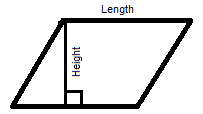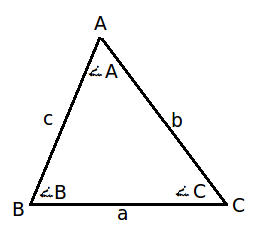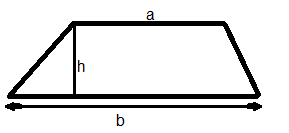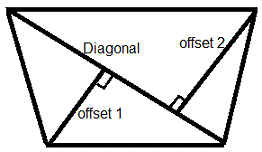
Formula of mensuration
Mensuration of Class 8
SOME IMPORTANT FORMULAE
Area and perimeter of Rectangle and Square
- Area of rectangle (A) = length(l) × Breath(b), A = l× b
- Perimeter of a rectangle (P) = 2 × (Length(l) + Breath(b)), P = 2 × (l + b)
- Area of a square (A) = Length (l) × Length (l), A = l×l
- Perimeter of a square (P) = 4 × Length (l), P = 4 ×l
Related Topics
SOLVED EXAMPLES
Question. Find the perimeter and area of a rectangle with length 8 cm and breadth 10 cm.
Sol. Given l = 8 cm and b = 10 cm
∴ Perimeter = 2 (l + b)
= 2 × (8 + 10) cm = 36 cm.
Area = (l × b)= (8 × 10)cm 2 = 80 cm 2 .
Question. The perimeter of a rectangle is 50 cm and its breadth is 9 cm. Find the length and area of the rectangle.
Sol.Let the length be l cm. Then,
2(l + b) = Perimeter ⇒ 2 × (l + 9) = 50
∴ Length = 16 cm.
Area = (l × b) = (16 × 9) cm 2 = 144 cm 2 .
Hence, the length of rectangle is 16 cm and its area is 144 cm 2 .

Questions:
Question 1. Find the perimeter and area of a square with side 11 cm
Question 2. ………… is a direction in which one can measure distance.
Question 3. A square and a rectangular field with measurements as given in the figure have the same perimeter. Which field has a larger area?



6 cm 8 cm

Answers:
1. 44 cm , 121 cm 2 2. Dimension 3. both will have equal
1. Find the perimeter and area of a square with side 11 cm
Sol: Side = 11 cm
So, perimeter of the square is = 4 × Side
= 4 × 11
= 44 cm
Area of the square = (side) 2
= (11) 2
= 121 cm 2
3. A square and a rectangular field with measurements as given in the figure have the same perimeter. Which field has a larger area?



6 cm

8 cm
Sol : Perimeter of square = 4 (Side of the square) = 4 (6 m) = 24 m
Perimeter of rectangle = 2 (Length + Breadth)
= 2 (8 m + Breadth)
= 16 m + 2 × Breadth
It is given that the perimeter of the square and the rectangle are the same.
16 m + 2 × Breadth = 24 m
5. Area of parallelogram(A) = Length(l) × (Height(h), A = l× h

6. Perimeter of a parallelogram (P) = 2 ×( (length(l) + Breadth(b))
Perimeter of a parallelogram (P) = 2 ×( (length(l) + Breadth(b)), P = 2 × (l + b)
7.
Area of a triangle (A) = (Base(b) × (Height(b)) / 2,


And for a triangle with sides measuring “a” , “b” and “c” , Perimeter = a+b+c
and s = semi perimeter = perimeter / 2 = (a+b+c)/2
And also . Area of triangle =

This formulas is also knows as “Heroe’s formula”.
8. Area of triangle(A) =
Where , A , B and C are the vertex and angle A , B , C are respective angles of triangles and a , b , c are the respective opposite sides of the angles as shown in figure below:

9.
Area of isosceles triangle =

Where , a = length of two equal side , b= length of base of isosceles triangle.
10.
Area of trapezium (A) =

Where , “a” and “b” are the length of parallel sides and “h” is the perpendicular distance between “a” and “b” .

11. Perimeter of a trapezium (P) = sum of all sides
12. Area f rhombus (A) = Product of diagonals / 2
13. Perimeter of a rhombus (P) = 4 × l
where l = length of a side
14. Area of quadrilateral (A) = 1/2 × Diagonal ×( (Sum of offsets)

15. Area of a Kite (A) = 1/2 × product of it’s diagonals
16. Perimeter of a Kite (A) = 2 × Sum on non-adjacent sides
SOLVED EXAMPLES
Question. The base of a triangle is 24 cm and its corresponding height is 15 cm. Find the area of the triangle.
Solution:
Area of the triangle
 sq. units.
sq. units.

Question. Find the area of a parallelogram whose base is 4 m and height 50 cm.
Solution:
Given : Base = 4 m, Height = 50 cm

∴ Area of the parallelogram = (Base × Height) sq. units. = (4 × 0.5) m 2 = 2 m 2
Question. Find the area of the rhombus, the lengths of whose diagonals are 15 cm and 19 cm.
Solution:
Area of the rhombus =
 × (product of diagonals)
× (product of diagonals)
 = 142.5 cm
2
.
= 142.5 cm
2
.
∴ The area of the given rhombus is 142.5 cm 2 .
CBSE NCERT Solutions for Class 8 Maths
class 8 maths NCERT solutions Chapter 1: Rational Numbers
class 8 maths NCERT solutions Chapter 2: Linear Equations in One Variable
class 8 maths NCERT solutions Chapter 3: Understanding Quadrilaterals
class 8 maths NCERT solutions Chapter 4: Practical Geometry
class 8 maths NCERT solutions Chapter 5: Data Handling
class 8 maths NCERT solutions Chapter 6: Square and Square Roots
class 8 maths NCERT solutions Chapter 7: Cube and Cube Roots
class 8 maths NCERT solutions Chapter 8: Comparing Quantities
NCERT Class 8 Maths solution Chapter 9: Algebraic Expressions and Identities
class 8 maths NCERT solutions Chapter 10: Visualizing Solid Shapes
class 8 maths NCERT solutions Chapter 11: Mensuration
class 8 maths NCERT solutions Chapter 12: Exponents and Powers
class 8 maths NCERT solutions Chapter 13: Direct and Inverse Proportions
class 8 maths NCERT solutions Chapter 14: Factorization
class 8 maths NCERT solutions Chapter 15: Introduction to Graphs
class 8 maths NCERT solutions Chapter 16: Playing with Numbers
Notes,worksheet and solved question for Maths class 8
- class 8 maths notes on chapter Liner equation in one variable
- class 8 maths notes on chapter algebric expression
- class 8 maths notes on chapter Mensuration
- class 8 maths notes on chapter Square and square roots
- class 8 maths notes on chapter statistice
- class 8 maths notes on chapter practical Geometry
- class 8 maths notes on chapter commericial maths
- class 8 maths notes on chapter solid shape
- class 8 maths notes on chapter quadrilaterals
- class 8 maths notes on chapter exponents
- c lass 8 maths notes on chapter factorisation
- class 8 maths notes on chapter inverse proporation
- class 8 maths notes on chapter cube and cube roots
Check your marks in a chapter which you have complited in school from Physics Wallah chapter wise online test just click on the link given below









